Advances and Challenges in Oxygen Carriers for Chemical Looping Partial Oxidation of Methane
Abstract
:1. Introduction
2. Fundamentals of CLPO and CLPOM
3. Synthesis Methods of OCs
4. Design Strategies of OCs
4.1. Single-Metal Oxide
4.1.1. Ni-Based OCs
4.1.2. Fe-Based OCs
4.1.3. Ce-Based OCs
4.1.4. Other Metal Oxide-Based OCs
4.2. Complex Metal Oxide
4.2.1. Spinel-Type (AB2O4) OCs
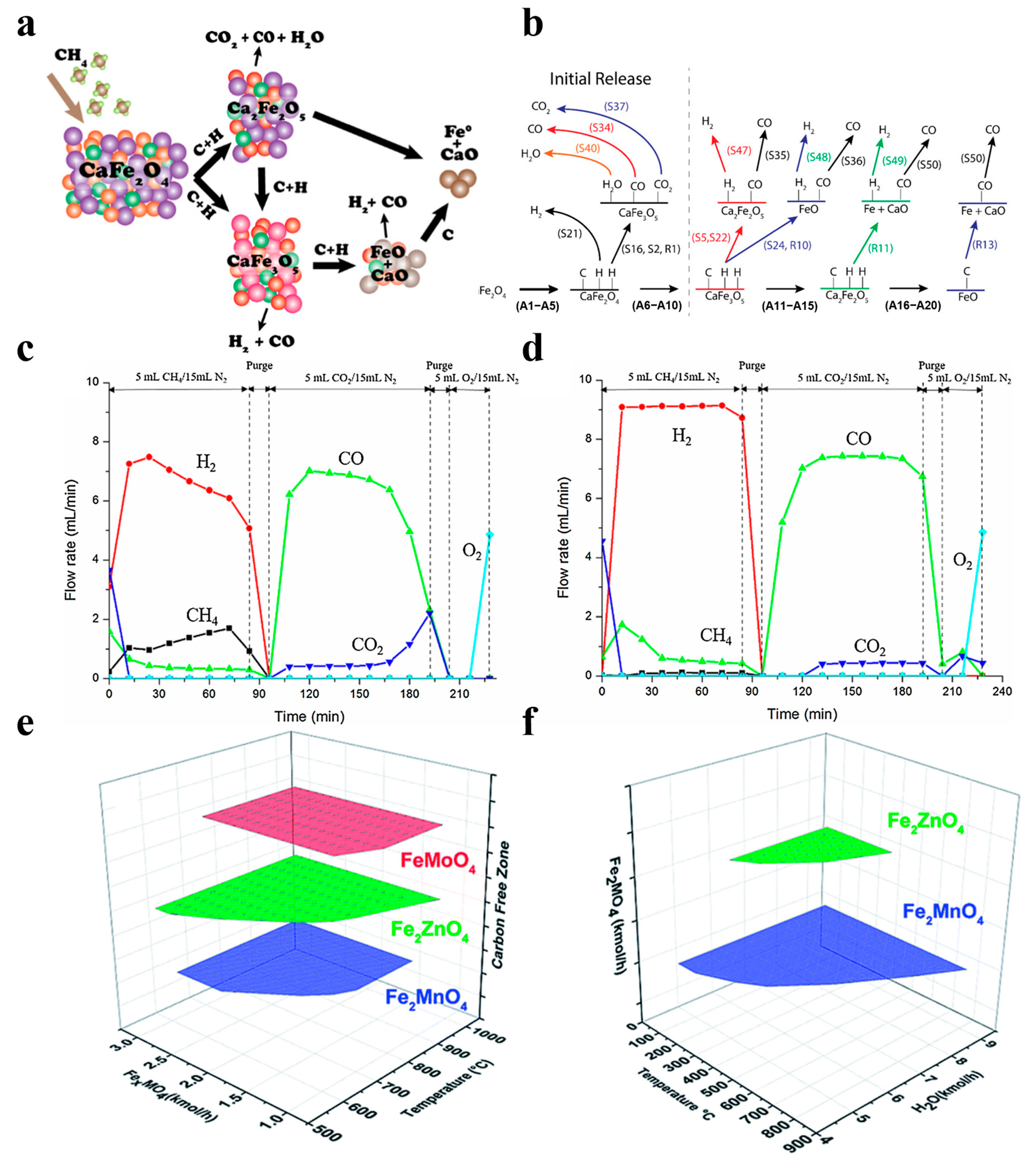
4.2.2. Perovskite (ABO3) OCs
4.3. Function of Supports
5. Conclusions
Author Contributions
Funding
Data Availability Statement
Conflicts of Interest
References
- Wang, F.; Chen, S.; Duan, L.; Xiang, W. Carbon Dioxide Capture and Hydrogen Production with a Chemical Looping Concept: A Review on Oxygen Carrier and Reactor. Energy Fuels 2023, 37, 16245–16266. [Google Scholar] [CrossRef]
- Luo, S.; Zeng, L.; Fan, L.-S. Chemical Looping Technology: Oxygen Carrier Characteristics. Annu. Rev. Chem. Biomol. Eng. 2015, 6, 53–75. [Google Scholar] [CrossRef] [PubMed]
- Zhang, X.; Zhang, F.; Song, Z.; Lin, L.; Zhao, X.; Sun, J.; Mao, Y.; Wang, W. Review of chemical looping process for carbonaceous feedstock Conversion: Rational design of oxygen carriers. Fuel 2022, 325, 124964. [Google Scholar] [CrossRef]
- Yang, Z.; Zeng, M.; Wang, K.; Yue, X.; Chen, X.; Dai, W.; Fu, X. Visible light-assisted thermal catalytic reverse water gas reaction over Cu-CeO2: The synergistic of hot electrons and oxygen vacancies induced by LSPR effect. Fuel 2022, 315, 123186. [Google Scholar] [CrossRef]
- Li, Y.; Chen, M.; Jiang, L.; Tian, D.; Li, K. Perovskites as oxygen storage materials for chemical looping partial oxidation and reforming of methane. Phys. Chem. Chem. Phys. 2024, 26, 1516–1540. [Google Scholar] [CrossRef] [PubMed]
- De Vos, Y.; Jacobs, M.; Van Der Voort, P.; Van Driessche, I.; Snijkers, F.; Verberckmoes, A. Development of Stable Oxygen Carrier Materials for Chemical Looping Processes—A Review. Catalysts 2020, 10, 926. [Google Scholar] [CrossRef]
- Sunny, A.A.; Meng, Q.; Kumar, S.; Joshi, R.; Fan, L.-S. Nanoscaled Oxygen Carrier-Driven Chemical Looping for Carbon Neutrality: Opportunities and Challenges. Acc. Chem. Res. 2023, 56, 3404–3416. [Google Scholar] [CrossRef] [PubMed]
- Zhu, X.; Imtiaz, Q.; Donat, F.; Müller, C.R.; Li, F. Chemical looping beyond combustion—A perspective. Energy Environ. Sci. 2020, 13, 772–804. [Google Scholar] [CrossRef]
- Otsuka, K.; Wang, Y.; Sunada, E.; Yamanaka, I. Direct partial oxidation of methane to synthesis gas by cerium oxide. J. Catal. 1998, 175, 152–160. [Google Scholar] [CrossRef]
- Steinfeld, A.; Kuhn, P.; Karni, J. High-temperature solar thermochemistry: Production of iron and synthesis gas by Fe3O4-reduction with methane. Energy 1993, 18, 239–249. [Google Scholar] [CrossRef]
- Zheng, Y.; Li, K.; Wang, H.; Tian, D.; Wang, Y.; Zhu, X.; Wei, Y.; Zheng, M.; Luo, Y. Designed oxygen carriers from macroporous LaFeO3 supported CeO2 for chemical-looping reforming of methane. Appl. Catal. B Environ. 2017, 202, 51–63. [Google Scholar] [CrossRef]
- Zhao, K.; Zheng, A.; Li, H.; He, F.; Huang, Z.; Wei, G.; Shen, Y.; Zhao, Z. Exploration of the mechanism of chemical looping steam methane reforming using double perovskite-type oxides La1.6Sr0.4FeCoO6. Appl. Catal. B Environ. 2017, 219, 672–682. [Google Scholar] [CrossRef]
- Kulkarni, P.; Guan, J.; Subia, R.; Cui, Z.; Manke, J.; Frydman, A.; Wei, W.; Shisler, R.; Ayala, R.; Rizeq, G. Fuel-Flexible Gasification-Combustion Technology for Production of H2 and Sequestration-Ready CO2; GE Energy & Environmental Research Corporation: Irvine, CA, USA, 2008. [Google Scholar]
- Jia, Z.; Li, H.; He, B.; Xu, B.; Shao, L.; Chen, H.; Li, K.; Zeng, L. Design Basis of 1 MWth Calcium Looping Gasification Pilot Unit. In Proceedings of the International Pittsburgh Coal Conference, Zuzhou, China, 15–18 October 2018. [Google Scholar]
- Chung, C.; Qin, L.; Shah, V.; Fan, L.-S. Chemically and physically robust, commercially-viable iron-based composite oxygen carriers sustainable over 3000 redox cycles at high temperatures for chemical looping applications. Energy Environ. Sci. 2017, 10, 2318–2323. [Google Scholar] [CrossRef]
- Fan, L.-S.; Zeng, L.; Wang, W.; Luo, S. Chemical looping processes for CO2 capture and carbonaceous fuel conversion–prospect and opportunity. Energy Environ. Sci. 2012, 5, 7254–7280. [Google Scholar] [CrossRef]
- Zeng, L.; Kathe, M.V.; Chung, E.Y.; Fan, L.-S. Some remarks on direct solid fuel combustion using chemical looping processes. Curr. Opin. Chem. Eng. 2012, 1, 290–295. [Google Scholar] [CrossRef]
- Qin, L.; Cheng, Z.; Fan, J.A.; Kopechek, D.; Xu, D.; Deshpande, N.; Fan, L.-S. Nanostructure formation mechanism and ion diffusion in iron–titanium composite materials with chemical looping redox reactions. J. Mater. Chem. A 2015, 3, 11302–11312. [Google Scholar] [CrossRef]
- Sun, Z.; Russell, C.K.; Whitty, K.J.; Eddings, E.G.; Dai, J.; Zhang, Y.; Fan, M.; Sun, Z. Chemical looping-based energy transformation via lattice oxygen modulated selective oxidation. Prog. Energy Combust. Sci. 2023, 96, 101045. [Google Scholar] [CrossRef]
- Zheng, Y.; Marek, E.J.; Scott, S.A. H2 production from a plasma-assisted chemical looping system from the partial oxidation of CH4 at mild temperatures. Chem. Eng. J. 2020, 379, 122197. [Google Scholar] [CrossRef]
- Qin, L.; Guo, M.; Liu, Y.; Cheng, Z.; Fan, J.A.; Fan, L.-S. Enhanced methane conversion in chemical looping partial oxidation systems using a copper doping modification. Appl. Catal. B Environ. 2018, 235, 143–149. [Google Scholar] [CrossRef]
- Zeng, L.; Cheng, Z.; Fan, J.A.; Fan, L.-S.; Gong, J. Metal oxide redox chemistry for chemical looping processes. Nat. Rev. Chem. 2018, 2, 349–364. [Google Scholar] [CrossRef]
- Liu, R.; Zhang, X.; Liu, T.; Yao, X.; Zhao, Z.; Pei, C.; Gong, J. Dynamic oxygen migration and reaction over ceria-supported nickel oxides in chemical looping partial oxidation of methane. Appl. Catal. B Environ. 2023, 328, 122478. [Google Scholar] [CrossRef]
- Carrillo, A.J.; Navarrete, L.; Laqdiem, M.; Balaguer, M.; Serra, J.M. Boosting methane partial oxidation on ceria through exsolution of robust Ru nanoparticles. Mater. Adv. 2021, 2, 2924–2934. [Google Scholar] [CrossRef]
- Li, X.; Li, Z.; Lu, C.; Li, D.; Li, Z.; Gao, J.; Wei, J.; Li, K. Enhanced performance of LaFeO3 oxygen carriers by NiO for chemical looping partial oxidation of methane. Fuel Process. Technol. 2022, 236, 107396. [Google Scholar] [CrossRef]
- Yao, X.; Zhang, X.; Liu, R.; Pei, C.; Zhao, Z.J.; Gong, J. Oxygen activity regulation over LaNiO3 perovskites by Ti substitution for chemical looping partial oxidation of methane. Chem. Eng. Sci. 2023, 278, 118911. [Google Scholar] [CrossRef]
- Zhao, K.; Zhang, R.; Gao, Y.; Lin, Y.; Liu, A.; Wang, X.; Zheng, A.; Huang, Z.; Zhao, Z. High syngas selectivity and near pure hydrogen production in perovskite oxygen carriers for chemical looping steam methane reforming. Fuel Process. Technol. 2022, 236, 107398. [Google Scholar] [CrossRef]
- Li, C.; Li, W.; Liao, Y.; Liang, S.; Ma, X. Oxygen uncoupling chemical looping gasification of biomass over heterogeneously doped La-Fe-O perovskite-type oxygen carriers. Fuel Process. Technol. 2023, 250, 107883. [Google Scholar] [CrossRef]
- Kim, H.S.; Kim, Y.; Lim, H.S.; Kim, H.; Lee, J.W. Surface enrichment of lanthanum on Co3O4 for stable chemical looping combustion. J. CO2 Util. 2023, 73, 102532. [Google Scholar] [CrossRef]
- Ding, H.; Jin, Y.; Hawkins, S.C.; Zhang, L.; Luo, C. Development and performance of CeO2 supported BaCoO3−δ perovskite for chemical looping steam methane reforming. Fuel Process. Technol. 2023, 239, 1075463. [Google Scholar] [CrossRef]
- Rao, Z.; Wang, K.; Cao, Y.; Feng, Y.; Huang, Z.; Chen, Y.; Wei, S.; Liu, L.; Gong, Z.; Cui, Y.; et al. Light-Reinforced Key Intermediate for Anticoking To Boost Highly Durable Methane Dry Reforming over Single Atom Ni Active Sites on CeO2. J. Am. Chem. Soc. 2023, 145, 24625–24635. [Google Scholar] [CrossRef] [PubMed]
- Zhang, X.; Wang, J.; Song, Z.; Zhao, X.; Sun, J.; Mao, Y.; Wang, W. Co3O4-CeO2 for enhanced syngas by low-temperature methane conversion with CO2 utilization via a catalytic chemical looping process. Fuel Process. Technol. 2023, 245, 107741. [Google Scholar] [CrossRef]
- Liu, Y.; Qin, L.; Cheng, Z.; Goetze, J.W.; Kong, F.; Fan, J.A.; Fan, L.-S. Near 100% CO selectivity in nanoscaled iron-based oxygen carriers for chemical looping methane partial oxidation. Nat. Commun. 2019, 10, 5503. [Google Scholar] [CrossRef] [PubMed]
- Fang, Y.; Wang, Z.; Wang, C.; Duan, H.; Li, Y.; Zhang, G. Enhanced Methane Conversion in Chemical Looping Partial Oxidation of Iron-Based Oxygen Carriers. JOM 2023, 75, 1530–1539. [Google Scholar] [CrossRef]
- Zong, T.; Li, L.; Han, Y.; Wang, C.; Kang, Y.; Tian, M.; Huang, C.; Wang, X. Influence of the encapsulation degree of Fe0 active sites on performance of garnets for chemical looping partial oxidation of CH4. Appl. Catal. B Environ. 2022, 312, 121421. [Google Scholar] [CrossRef]
- Cabello, A.; Mendiara, T.; Abad, A.; Izquierdo, M.T.; García-Labiano, F. Production of hydrogen by chemical looping reforming of methane and biogas using a reactive and durable Cu-based oxygen carrier. Fuel 2022, 322, 124250. [Google Scholar] [CrossRef]
- Wang, C.; Fang, Y.; Wang, Z.; Long, M.; Chen, D.; Duan, H.; Li, Y.; Zhang, G. Performance and mechanism study of Ce2(SO4)3 for methane chemical looping partial oxidation. Fuel 2023, 334, 126817. [Google Scholar] [CrossRef]
- Yang, J.; Bjørgum, E.; Chang, H.; Zhu, K.-K.; Sui, Z.-J.; Zhou, X.-G.; Holmen, A.; Zhu, Y.-A.; Chen, D. On the ensemble requirement of fully selective chemical looping methane partial oxidation over La-Fe-based perovskites. Appl. Catal. B Environ. 2022, 301, 120788. [Google Scholar] [CrossRef]
- Chein, R.-Y.; Lu, C.-Y.; Chen, W.-H. Syngas production via chemical looping reforming using methane-based feed and NiO/Al2O3 oxygen carrier. Energy 2022, 250, 123815. [Google Scholar] [CrossRef]
- Sun, X.; Zhu, L.; Zhao, W.; Li, F.; Chen, X. Ni-Fe bimetallic hexaaluminate for efficient reduction of O2-containing CO2 via chemical looping. Chem. Eng. J. 2022, 441, 136071. [Google Scholar] [CrossRef]
- Zheng, Y.; Sukma, M.S.; Scott, S.A. The exploration of NiO/Ca2Fe2O5/CaO in chemical looping methane conversion for syngas and H2 production. Chem. Eng. J. 2023, 465, 142779. [Google Scholar] [CrossRef]
- Song, H.; Wang, W.; Sun, J.; Wang, X.; Zhang, X.; Chen, S.; Pei, C.; Zhao, Z.-J. Chemical looping oxidative propane dehydrogenation controlled by oxygen bulk diffusion over FeVO4 oxygen carrier pellets. Chin. J. Chem. Eng. 2023, 53, 409–420. [Google Scholar] [CrossRef]
- Li, Y.; Liu, M.; Zhang, J.; Yang, T.; Rao, Q.; Gai, Z.; Wang, X.; Pan, Y.; Jin, H. Mid-temperature chemical looping methane reforming for hydrogen production via iron-based oxygen carrier particles. Fuel Process. Technol. 2024, 253, 108026. [Google Scholar] [CrossRef]
- Lv, Y.; Cheng, B.; Yang, H.; Cui, X.; Zhao, M. Chemical looping partial oxidation (CLPO) of toluene on LaFeO3 perovskites for tunable syngas production. Chem. Eng. J. 2023, 451, 138968. [Google Scholar] [CrossRef]
- Oh, D.; Colombo, F.; Nodari, L.; Kim, J.H.; Kim, J.K.; Lee, S.; Kim, S.; Kim, S.; Lim, D.-K.; Seo, J.; et al. Rocking chair-like movement of ex-solved nanoparticles on the Ni-Co doped La0.6Ca0.4FeO3-δ oxygen carrier during chemical looping reforming coupled with CO2 splitting. Appl. Catal. B Environ. 2023, 332, 122745. [Google Scholar] [CrossRef]
- Yang, C.; Zhang, J.; Wang, J.; Li, D.; Li, K.; Zhu, X. Oxygen vacancies enriched Ni-Co/SiO2@CeO2 redox catalyst for cycling methane partial oxidation and CO2 splitting. Chin. J. Chem. Eng. 2023, 63, 235–245. [Google Scholar] [CrossRef]
- Khani, H.; Khandan, N.; Eikani, M.H.; Eliassi, A. Investigation of synthesized Fe2O3 and CuO–Fe2O3 for pure hydrogen production by chemical-loop reformng of methanol in a micro-channel reactor. Int. J. Hydrogen Energy 2023, 48, 6436–6450. [Google Scholar] [CrossRef]
- Long, Y.; Gu, Z.; Lin, S.; Yang, K.; Zhu, X.; Wei, Y.; Wang, H.; Li, K. NiO and CuO coated monolithic oxygen carriers for chemical looping combustion of methane. J. Energy Inst. 2021, 94, 199–209. [Google Scholar] [CrossRef]
- Li, Z.; Feng, X.; Gu, Z.; Lu, C.; Li, D.; Zhu, X.; Jiang, L.; Deng, G.; Li, K. Enhanced performance of the CeO2MgO oxygen carrier by NiO for chemical looping CO2 splitting. Fuel Process. Technol. 2022, 225, 107045. [Google Scholar] [CrossRef]
- Zhang, Y.-k.; Zhao, Y.-j.; Yi, Q.; Wei, G.-q.; Shi, L.-j.; Zhou, H. NiO/κ-CeZrO4 functional oxygen carriers with Niδ+ and oxygen vacancy synergy for chemical looping partial oxidation reforming of methane. Fuel Process. Technol. 2021, 219, 106875. [Google Scholar] [CrossRef]
- Shah, V.; Cheng, Z.; Mohapatra, P.; Fan, L.-S. Enhanced methane conversion using Ni-doped calcium ferrite oxygen carriers in chemical looping partial oxidation systems with CO2 utilization. React. Chem. Eng. 2021, 6, 1928–1939. [Google Scholar] [CrossRef]
- Zhang, Q.; Li, L.; Jiang, B.; Wang, K.; Tang, D.; Dou, B. An intelligent oxygen carrier of La2−xSrxNiO4−λ for hydrogen production by chemical looping reforming of ethanol. Int. J. Hydrogen Energy 2017, 42, 17102–17111. [Google Scholar] [CrossRef]
- Ashok, J.; Kathiraser, Y.; Ang, M.L.; Kawi, S. Bi-functional hydrotalcite-derived NiO–CaO–Al2O3 catalysts for steam reforming of biomass and/or tar model compound at low steam-to-carbon conditions. Appl. Catal. B Environ. 2015, 172–173, 116–128. [Google Scholar] [CrossRef]
- Huang, Z.; Deng, Z.; Chen, D.; Wei, G.; He, F.; Zhao, K.; Zheng, A.; Zhao, Z.; Li, H. Exploration of Reaction Mechanisms on Hydrogen Production through Chemical Looping Steam Reforming Using NiFe2O4 Oxygen Carrier. ACS Sustain. Chem. Eng. 2019, 7, 11621–11632. [Google Scholar] [CrossRef]
- Chen, J.; Zhao, K.; Zhao, Z.; He, F.; Huang, Z.; Wei, G. Identifying the roles of MFe2O4 (M=Cu, Ba, Ni, and Co) in the chemical looping reforming of char, pyrolysis gas and tar resulting from biomass pyrolysis. Int. J. Hydrogen Energy 2019, 44, 4674–4687. [Google Scholar] [CrossRef]
- Huang, J.; Liu, W.; Yang, Y.; Liu, B. High-Performance Ni–Fe Redox Catalysts for Selective CH4 to Syngas Conversion via Chemical Looping. ACS Catal. 2018, 8, 1748–1756. [Google Scholar] [CrossRef]
- Wang, D.; Jin, L.; Li, Y.; Wei, B.; Yao, D.; Hu, H. Upgrading of vacuum residue with chemical looping partial oxidation over Fe-Mn mixed metal oxides. Fuel 2019, 239, 764–773. [Google Scholar] [CrossRef]
- Feng, Y.; Wang, N.; Guo, X.; Zhang, S. Dopant screening of modified Fe2O3 oxygen carriers in chemical looping hydrogen production. Fuel 2020, 262, 116489. [Google Scholar] [CrossRef]
- Wang, D.; Jin, L.; Li, Y.; Hu, H. Upgrading of Heavy Oil with Chemical Looping Partial Oxidation over M2+ Doped Fe2O3. Energy Fuels 2018, 33, 257–265. [Google Scholar] [CrossRef]
- Zhu, Y.; Liu, W.; Sun, X.; Ma, X.; Kang, Y.; Wang, X.; Wang, J. La-hexaaluminate for synthesis gas generation by Chemical Looping Partial Oxidation of Methane Using CO2 as Sole Oxidant. AIChE J. 2017, 64, 550–563. [Google Scholar] [CrossRef]
- Hu, Q.; Shen, Y.; Chew, J.W.; Ge, T.; Wang, C.-H. Chemical looping gasification of biomass with Fe2O3/CaO as the oxygen carrier for hydrogen-enriched syngas production. Chem. Eng. J. 2020, 379, 122346. [Google Scholar] [CrossRef]
- Liu, R.; Pei, C.; Zhang, X.; Chen, S.; Li, H.; Zeng, L.; Mu, R.; Gong, J. Chemical looping partial oxidation over FeWO/SiO2 catalysts. Chin. J. Catal. 2020, 41, 1140–1151. [Google Scholar] [CrossRef]
- Donat, F.; Kierzkowska, A.; Müller, C.R. Chemical Looping Partial Oxidation of Methane: Reducing Carbon Deposition through Alloying. Energy Fuels 2022, 36, 9780–9784. [Google Scholar] [CrossRef]
- Chen, J.; Zhao, K.; Zhao, Z.; He, F.; Huang, Z.; Wei, G.; Xia, C. Reaction schemes of barium ferrite in biomass chemical looping gasification for hydrogen-enriched syngas generation via an outer-inner looping redox reaction mechanism. Energy Convers. Manag. 2019, 189, 81–90. [Google Scholar] [CrossRef]
- Kang, Y.; Tian, M.; Huang, C.; Lin, J.; Hou, B.; Pan, X.; Li, L.; Rykov, A.I.; Wang, J.; Wang, X. Improving Syngas Selectivity of Fe2O3/Al2O3 with Yttrium Modification in Chemical Looping Methane Conversion. ACS Catal. 2019, 9, 8373–8382. [Google Scholar] [CrossRef]
- Zeng, D.; Qiu, Y.; Peng, S.; Chen, C.; Zeng, J.; Zhang, S.; Xiao, R. Enhanced hydrogen production performance through controllable redox exsolution within CoFeAlOx spinel oxygen carrier materials. J. Mater. Chem. A 2018, 6, 11306–11316. [Google Scholar] [CrossRef]
- Zhu, M.; Chen, S.; Ma, S.; Xiang, W. Carbon formation on iron-based oxygen carriers during CH4 reduction period in Chemical Looping Hydrogen Generation process. Chem. Eng. J. 2017, 325, 322–331. [Google Scholar] [CrossRef]
- Li, D.; Xu, R.; Gu, Z.; Zhu, X.; Qing, S.; Li, K. Chemical-Looping Conversion of Methane: A Review. Energy Technol. 2019, 8, 1900925. [Google Scholar] [CrossRef]
- Wang, J.; Li, K.; Wang, H.; Li, Z.; Zhu, X. Sandwich Ni-phyllosilicate@doped-ceria for moderate-temperature chemical looping dry reforming of methane. Fuel Process. Technol. 2022, 232, 107268. [Google Scholar] [CrossRef]
- Riaz, A.; Kremer, F.; Kim, T.; Sattayaporn, S.; Tsuzuki, T.; Lipiński, W.; Lowe, A. Experimental demonstration of vanadium-doped nanostructured ceria for enhanced solar thermochemical syngas production. Nano Energy 2021, 81, 105639. [Google Scholar] [CrossRef]
- Kang, D.; Lee, M.; Lim, H.S.; Lee, J.W. Chemical looping partial oxidation of methane with CO2 utilization on the ceria-enhanced mesoporous Fe2O3 oxygen carrier. Fuel 2018, 215, 787–798. [Google Scholar] [CrossRef]
- Chen, S.; Zeng, L.; Tian, H.; Li, X.; Gong, J. Enhanced Lattice Oxygen Reactivity over Ni-Modified WO3-Based Redox Catalysts for Chemical Looping Partial Oxidation of Methane. ACS Catal. 2017, 7, 3548–3559. [Google Scholar] [CrossRef]
- Miller, D.D.; Riley, J.; Siriwardane, R. Interaction of Methane with Calcium Ferrite in the Chemical Looping Partial Oxidation Application: Experimental and DFT Study. Energy Fuels 2019, 34, 2193–2204. [Google Scholar] [CrossRef]
- Jiang, S.; Shen, L.; Wu, J.; Yan, J.; Song, T. The investigations of hematite-CuO oxygen carrier in chemical looping combustion. Chem. Eng. J. 2017, 317, 132–142. [Google Scholar] [CrossRef]
- Huang, Z.; Deng, Z.; Feng, Y.; Chen, T.; Chen, D.; Zheng, A.; Wei, G.; He, F.; Zhao, Z.; Wu, J.; et al. Exploring the Conversion Mechanisms of Toluene as a Biomass Tar Model Compound on NiFe2O4 Oxygen Carrier. ACS Sustain. Chem. Eng. 2019, 7, 16539–16548. [Google Scholar] [CrossRef]
- Huang, Z.; Deng, Z.; He, F.; Chen, D.; Wei, G.; Zhao, K.; Zheng, A.; Zhao, Z.; Li, H. Reactivity investigation on chemical looping gasification of biomass char using nickel ferrite oxygen carrier. Int. J. Hydrogen Energy 2017, 42, 14458–14470. [Google Scholar] [CrossRef]
- Chen, Z.; Zhang, J.; Li, D.; Li, K.; Wang, H.; Zhu, T.; Zhu, X. Enhanced performance of La1-xFeO3-δ oxygen carrier via A-site cation defect engineering for chemical looping dry reforming of methane. Fuel Process. Technol. 2023, 248, 107820. [Google Scholar] [CrossRef]
- Lim, H.S.; Kang, D.; Lee, J.W. Phase transition of Fe2O3–NiO to NiFe2O4 in perovskite catalytic particles for enhanced methane chemical looping reforming-decomposition with CO2 conversion. Appl. Catal. B Environ. 2017, 202, 175–183. [Google Scholar] [CrossRef]
- Zhang, J.; He, T.; Wang, Z.; Zhu, M.; Zhang, K.; Li, B.; Wu, J. The search of proper oxygen carriers for chemical looping partial oxidation of carbon. Appl. Energy 2017, 190, 1119–1125. [Google Scholar] [CrossRef]
- Collins-Martinez, V.H.; Cazares-Marroquin, J.F.; Salinas-Gutierrez, J.M.; Pantoja-Espinoza, J.C.; Lopez-Ortiz, A.; Melendez-Zaragoza, M.J. The thermodynamic evaluation and process simulation of the chemical looping steam methane reforming of mixed iron oxides. RSC Adv. 2020, 11, 684–699. [Google Scholar] [CrossRef] [PubMed]
- Shen, X.; Sun, Y.; Wu, Y.; Wang, J.; Jiang, E.; Xu, X.; Su, J.; Jia, Z. The coupling of CH4 partial oxidation and CO2 splitting for syngas production via double perovskite-type oxides LaFexCo1−xO3. Fuel 2020, 268, 117381. [Google Scholar] [CrossRef]
- Ksepko, E. Perovskite-type Sr(Mn1−xNix)O3 materials and their chemical-looping oxygen transfer properties. Int. J. Hydrogen Energy 2014, 39, 8126–8137. [Google Scholar] [CrossRef]
- Imtiaz, Q.; Hosseini, D.; Müller, C.R. Review of Oxygen Carriers for Chemical Looping with Oxygen Uncoupling (CLOU): Thermodynamics, Material Development, and Synthesis. Energy Technol. 2013, 1, 633–647. [Google Scholar] [CrossRef]
- Jiang, B.; Li, L.; Zhang, Q.; Ma, J.; Zhang, H.; Yu, K.; Bian, Z.; Zhang, X.; Ma, X.; Tang, D. Iron–oxygen covalency in perovskites to dominate syngas yield in chemical looping partial oxidation. J. Mater. Chem. A 2021, 9, 13008–13018. [Google Scholar] [CrossRef]
- Zhang, R.; Cao, Y.; Li, H.; Zhao, Z.; Zhao, K.; Jiang, L. The role of CuO modified La0·7Sr0·3FeO3 perovskite on intermediate-temperature partial oxidation of methane via chemical looping scheme. Int. J. Hydrogen Energy 2020, 45, 4073–4083. [Google Scholar] [CrossRef]
- Nalbandian, L.; Evdou, A.; Matsouka, C.; Zaspalis, V. Assessment of (La1-xSrx)MnO3±δ perovskites as oxygen- carrier materials in chemical-looping processes. Fuel Process. Technol. 2022, 226, 107086. [Google Scholar] [CrossRef]
- Zhang, L.; Hu, Y.; Xu, W.; Huang, C.; Su, Y.; Tian, M.; Zhu, Y.; Gong, H.; Wang, X. Anti-coke BaFe1–xSnxO3−δ Oxygen Carriers for Enhanced Syngas Production via Chemical Looping Partial Oxidation of Methane. Energy Fuels 2020, 34, 6991–6998. [Google Scholar] [CrossRef]
- Donat, F.; Müller, C.R. CO2-free conversion of CH4 to syngas using chemical looping. Appl. Catal. B Environ. 2020, 278, 119328. [Google Scholar] [CrossRef]
- Zhao, X.; Zhou, H.; Sikarwar, V.S.; Zhao, M.; Park, A.-H.A.; Fennell, P.S.; Shen, L.; Fan, L.-S. Biomass-based chemical looping technologies: The good, the bad and the future. Energy Environ. Sci. 2017, 10, 1885–1910. [Google Scholar] [CrossRef]
- Liu, G.; Liao, Y.; Wu, Y.; Ma, X.; Chen, L. Characteristics of microalgae gasification through chemical looping in the presence of steam. Int. J. Hydrogen Energy 2017, 42, 22730–22742. [Google Scholar] [CrossRef]

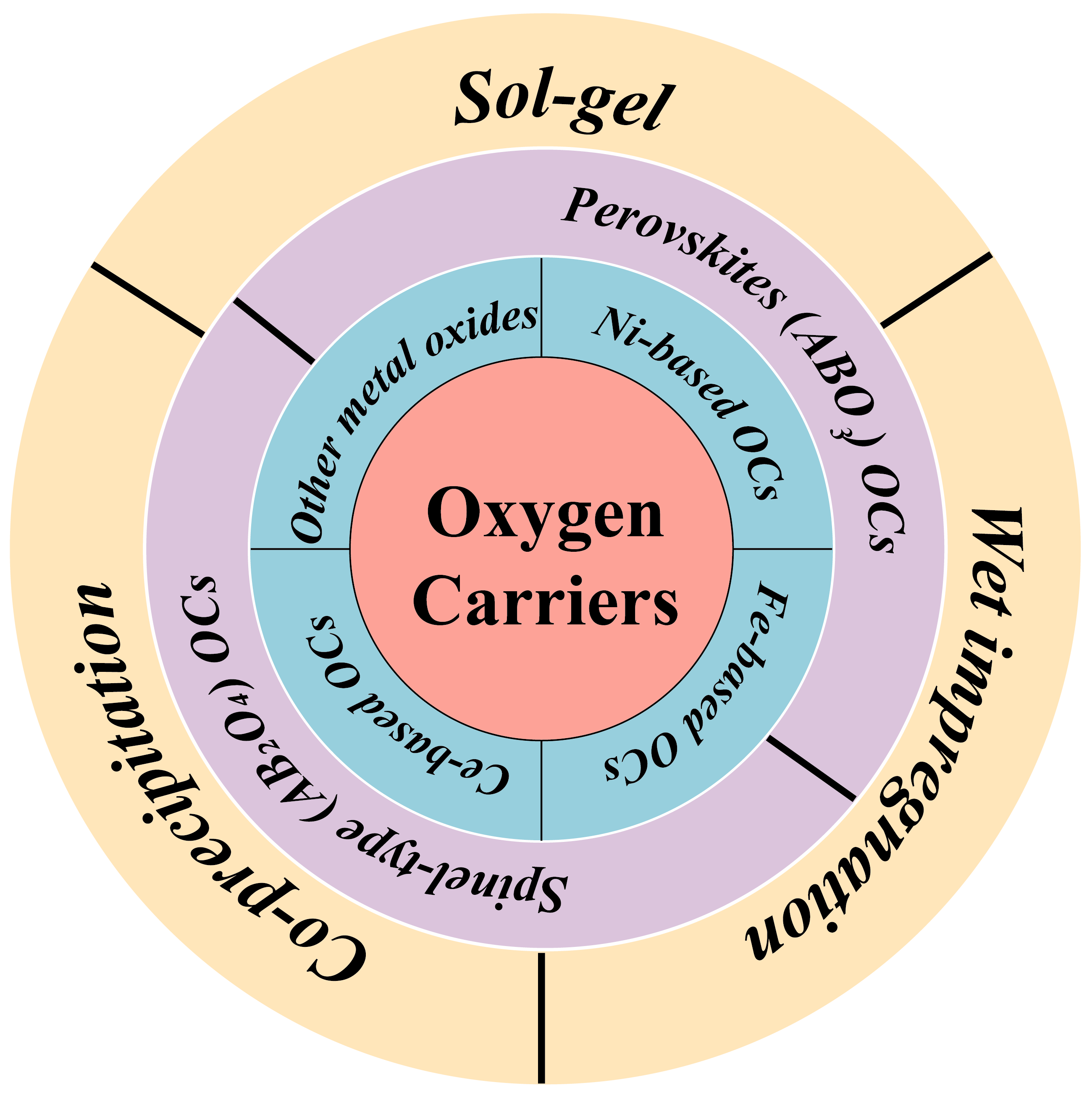
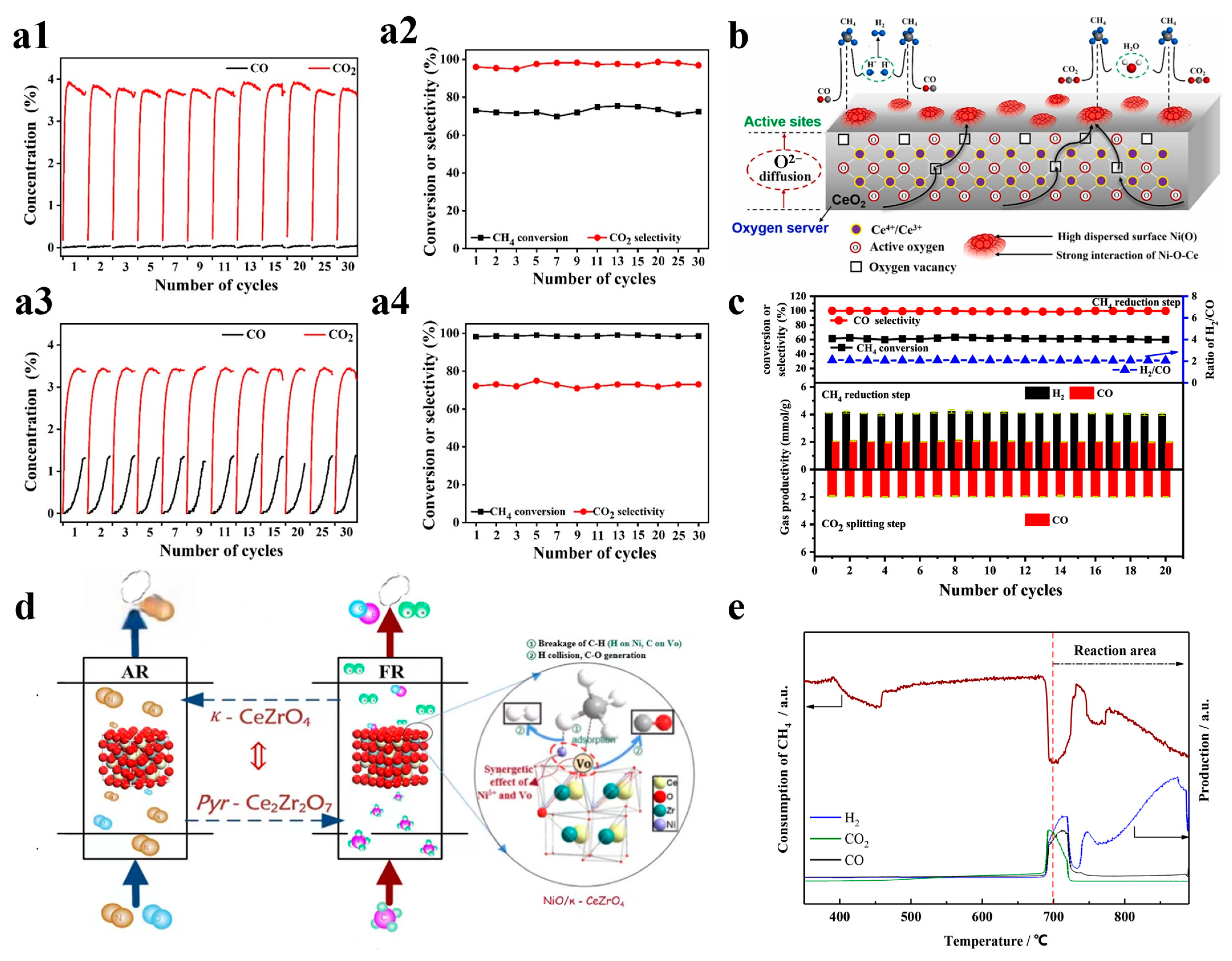
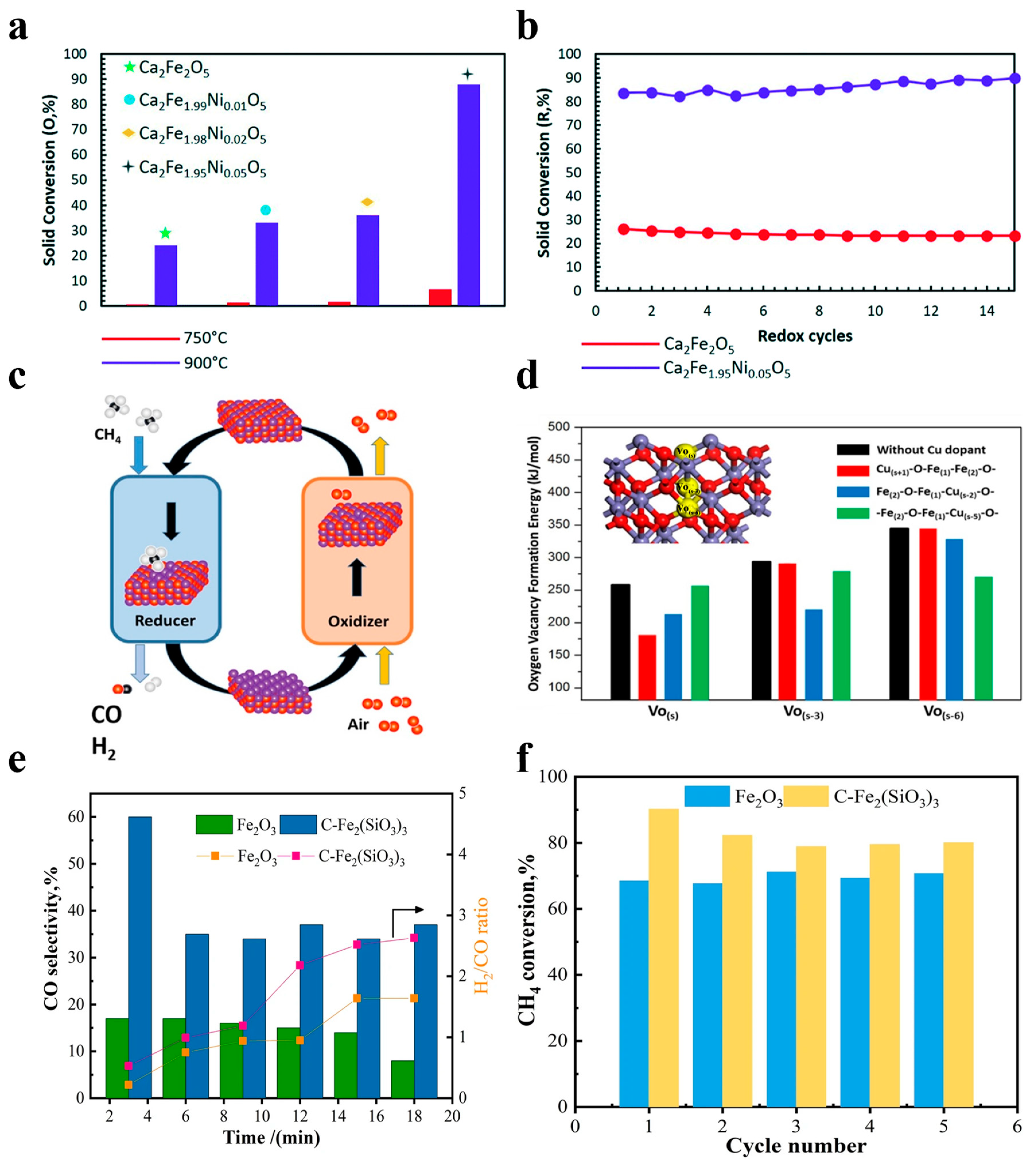
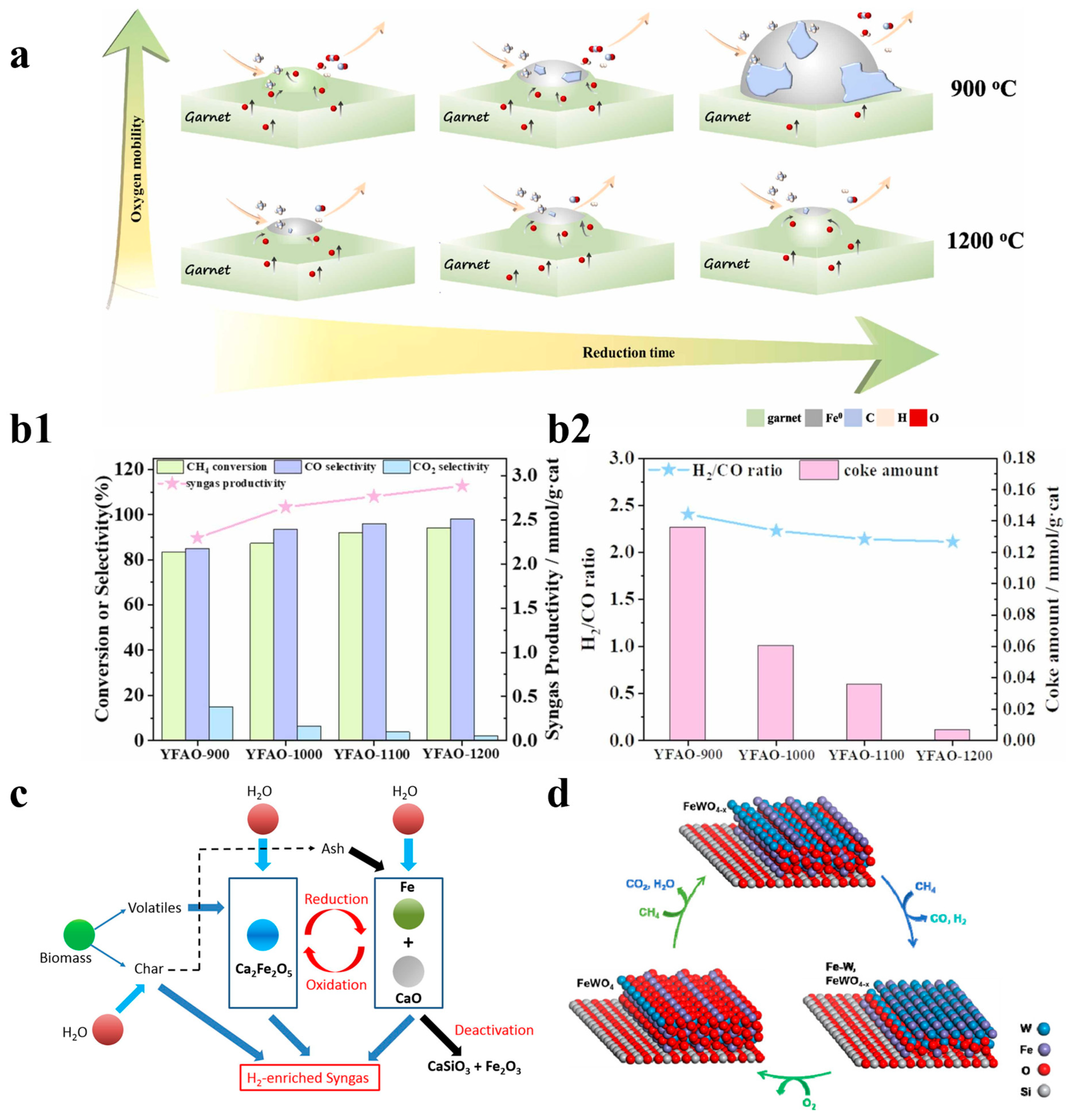
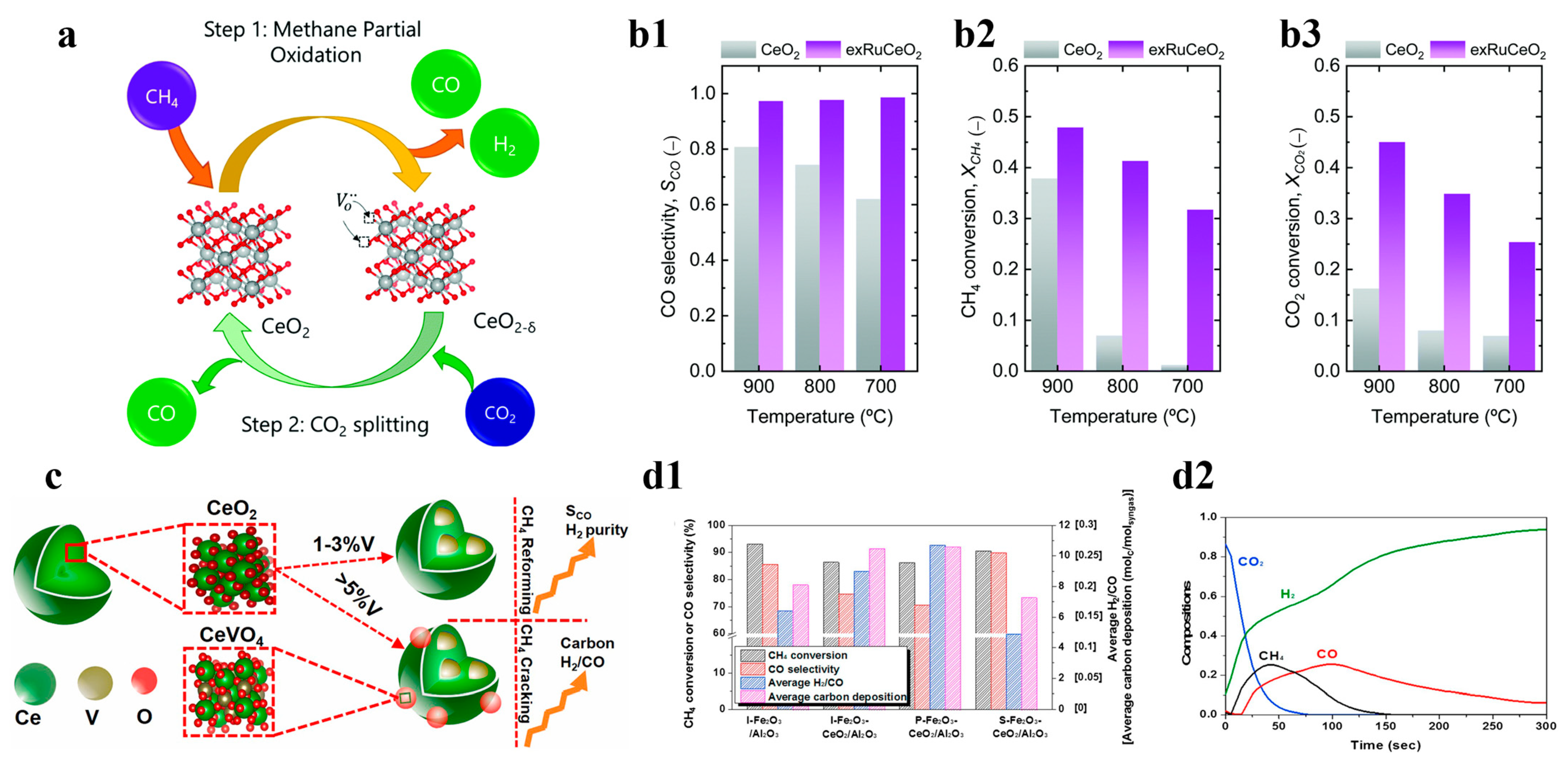
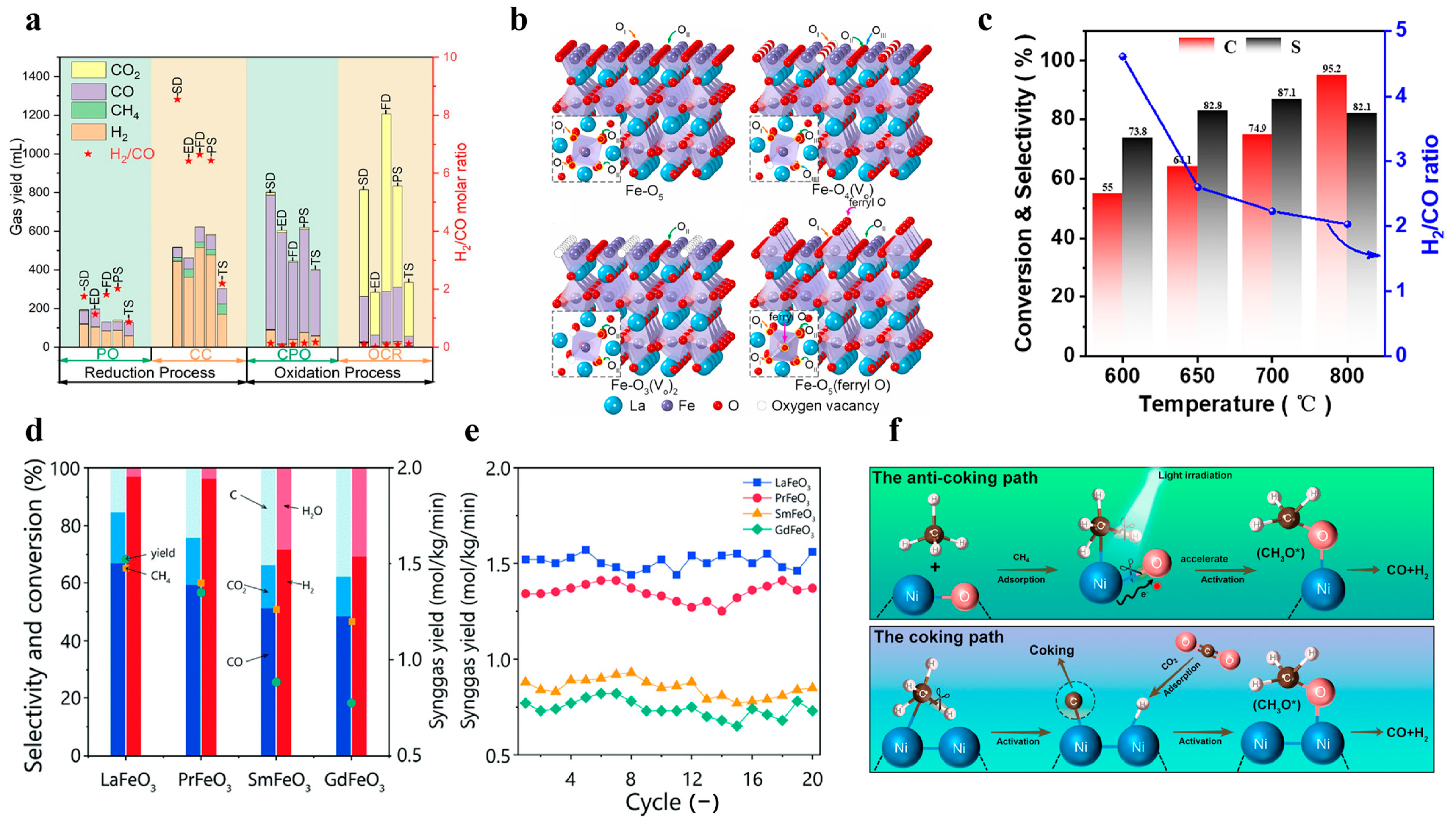
| Oxygen Carrier | Synthesis Method | Conv (CH4) | Sel (CO) | Yield (H2) | Temperature | Ref. |
|---|---|---|---|---|---|---|
| Fe2(SiO3)3 | Wet impregnation | 95% | 35% | - | 850 °C | [34] |
| Y3Fe2Al3O12 | Wet impregnation | 92% | ~100% | 0.06 mmol/g | - | [35] |
| Cu14Al | Wet impregnation | 96% | - | 2.60 mmol/g | 950 °C | [36] |
| Ce2(SO4)3 | - | 90.5% | 88.23% | - | 800 °C | [37] |
| LaFeO3 | Glycine–nitrate combustion | 70% | ~100% | - | 900 °C | [38] |
| NiO/Al2O3 | wetness Incipient impregnation | 90% | - | - | 800 °C | [39] |
| LaFe3−xNixAl9O19 | Co-precipitation | ~92% | ~82% | - | 850 °C | [40] |
| NiO/C2F/CaO | - | 55% | - | - | 700 °C | [41] |
| LaNixTi1−xO3−δ | - | ~100% | 80% | - | 800 °C | [31] |
| Ni/LaFeO3 | Wet impregnation | 95.2% | 85.1% | - | 800 °C | [25] |
| FeVO4 | - | 60% | 70% | - | 350 °C | [42] |
| Fe-P | Mechanical mixing | 86.2% | - | 42 mL/g | 600 °C | [43] |
| Co-LF | Sol–gel autocombustion | 75.15% | - | 1078.70 mL/g | 900 °C | [28] |
| LaFeO3 | - | ~100% | ~100% | 300 ml | 850 °C | [44] |
| Co3O4-CeO2 La0.95Ce0.05NixFe1−xO3 | Precipitation Sol–gel | 95% 95.7% | - 94.8% | - 55.72 mmol/g | 800 °C 800 °C | [32] [27] |
| BaCoO3−δ@CeO2 | Co-sol–gel | 50% | 93% | 123 mL/g | 850 °C | [30] |
| NiCo@La0.6Ca0.4FeO3−δ | Sol–gel | 78% | - | 10 mmol/g | 850 °C | [45] |
| Co/SiO2@CeO2 | Ammonia evaporation | 87% | 83% | - | 610 °C | [46] |
| Ce9Co1Oδ | Co-precipitation | 90% | 90% | - | 900 °C | [47] |
Disclaimer/Publisher’s Note: The statements, opinions and data contained in all publications are solely those of the individual author(s) and contributor(s) and not of MDPI and/or the editor(s). MDPI and/or the editor(s) disclaim responsibility for any injury to people or property resulting from any ideas, methods, instructions or products referred to in the content. |
© 2024 by the authors. Licensee MDPI, Basel, Switzerland. This article is an open access article distributed under the terms and conditions of the Creative Commons Attribution (CC BY) license (https://creativecommons.org/licenses/by/4.0/).
Share and Cite
Zhang, J.; Cui, Y.; Si-ma, W.; Zhang, Y.; Gao, Y.; Wang, P.; Zhang, Q. Advances and Challenges in Oxygen Carriers for Chemical Looping Partial Oxidation of Methane. Catalysts 2024, 14, 246. https://doi.org/10.3390/catal14040246
Zhang J, Cui Y, Si-ma W, Zhang Y, Gao Y, Wang P, Zhang Q. Advances and Challenges in Oxygen Carriers for Chemical Looping Partial Oxidation of Methane. Catalysts. 2024; 14(4):246. https://doi.org/10.3390/catal14040246
Chicago/Turabian StyleZhang, Jinnan, Yuxuan Cui, Wang Si-ma, Yanqi Zhang, Yuming Gao, Pengxuan Wang, and Qian Zhang. 2024. "Advances and Challenges in Oxygen Carriers for Chemical Looping Partial Oxidation of Methane" Catalysts 14, no. 4: 246. https://doi.org/10.3390/catal14040246
APA StyleZhang, J., Cui, Y., Si-ma, W., Zhang, Y., Gao, Y., Wang, P., & Zhang, Q. (2024). Advances and Challenges in Oxygen Carriers for Chemical Looping Partial Oxidation of Methane. Catalysts, 14(4), 246. https://doi.org/10.3390/catal14040246






